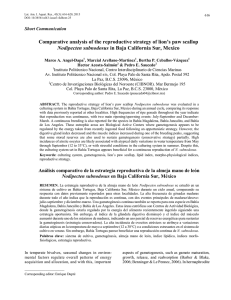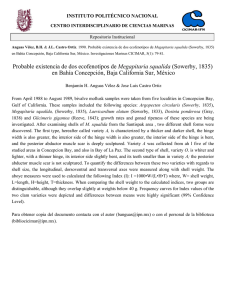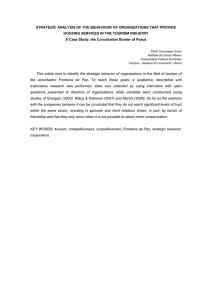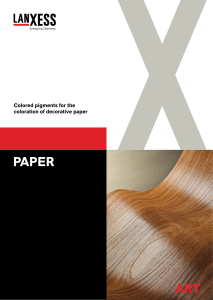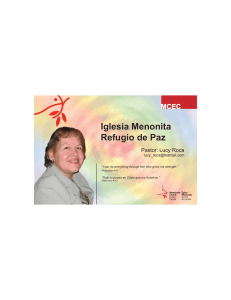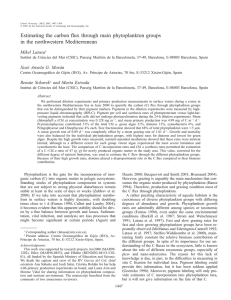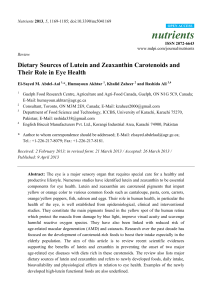The use of pigment “fingerprints” in the study of harmful algal blooms
Anuncio
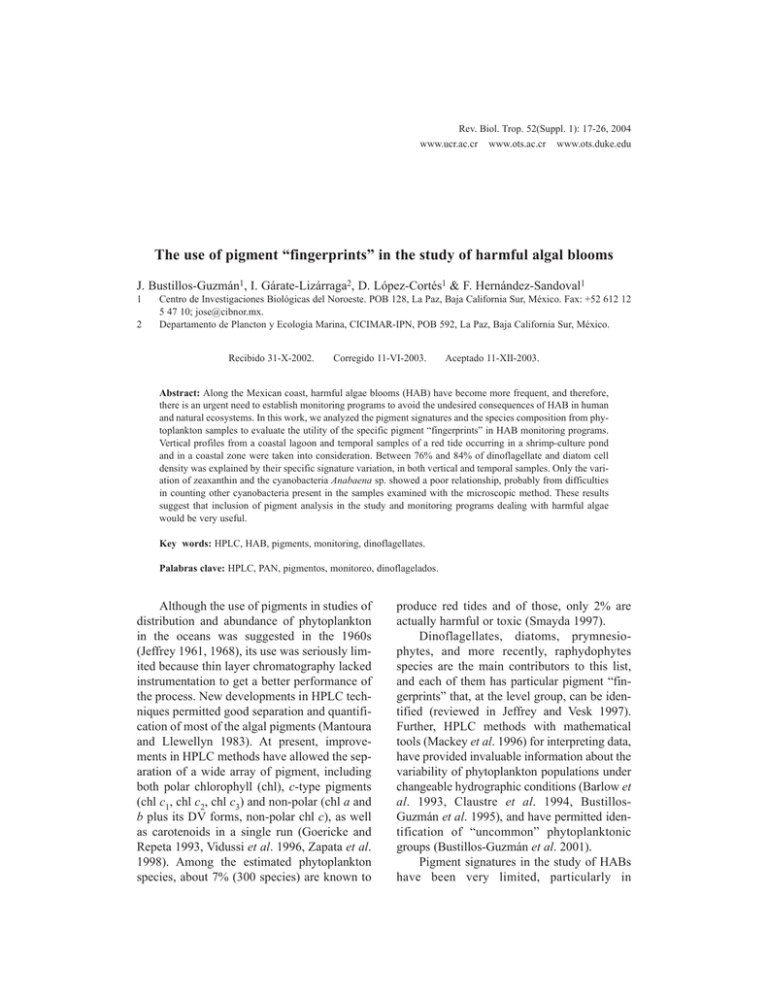
Rev. Biol. Trop. 52(Suppl. 1): 17-26, 2004 www.ucr.ac.cr www.ots.ac.cr www.ots.duke.edu The use of pigment “fingerprints” in the study of harmful algal blooms J. Bustillos-Guzmán1, I. Gárate-Lizárraga2, D. López-Cortés1 & F. Hernández-Sandoval1 1 2 Centro de Investigaciones Biológicas del Noroeste. POB 128, La Paz, Baja California Sur, México. Fax: +52 612 12 5 47 10; jose@cibnor.mx. Departamento de Plancton y Ecología Marina, CICIMAR-IPN, POB 592, La Paz, Baja California Sur, México. Recibido 31-X-2002. Corregido 11-VI-2003. Aceptado 11-XII-2003. Abstract: Along the Mexican coast, harmful algae blooms (HAB) have become more frequent, and therefore, there is an urgent need to establish monitoring programs to avoid the undesired consequences of HAB in human and natural ecosystems. In this work, we analyzed the pigment signatures and the species composition from phytoplankton samples to evaluate the utility of the specific pigment “fingerprints” in HAB monitoring programs. Vertical profiles from a coastal lagoon and temporal samples of a red tide occurring in a shrimp-culture pond and in a coastal zone were taken into consideration. Between 76% and 84% of dinoflagellate and diatom cell density was explained by their specific signature variation, in both vertical and temporal samples. Only the variation of zeaxanthin and the cyanobacteria Anabaena sp. showed a poor relationship, probably from difficulties in counting other cyanobacteria present in the samples examined with the microscopic method. These results suggest that inclusion of pigment analysis in the study and monitoring programs dealing with harmful algae would be very useful. Key words: HPLC, HAB, pigments, monitoring, dinoflagellates. Palabras clave: HPLC, PAN, pigmentos, monitoreo, dinoflagelados. Although the use of pigments in studies of distribution and abundance of phytoplankton in the oceans was suggested in the 1960s (Jeffrey 1961, 1968), its use was seriously limited because thin layer chromatography lacked instrumentation to get a better performance of the process. New developments in HPLC techniques permitted good separation and quantification of most of the algal pigments (Mantoura and Llewellyn 1983). At present, improvements in HPLC methods have allowed the separation of a wide array of pigment, including both polar chlorophyll (chl), c-type pigments (chl c1, chl c2, chl c3) and non-polar (chl a and b plus its DV forms, non-polar chl c), as well as carotenoids in a single run (Goericke and Repeta 1993, Vidussi et al. 1996, Zapata et al. 1998). Among the estimated phytoplankton species, about 7% (300 species) are known to produce red tides and of those, only 2% are actually harmful or toxic (Smayda 1997). Dinoflagellates, diatoms, prymnesiophytes, and more recently, raphydophytes species are the main contributors to this list, and each of them has particular pigment “fingerprints” that, at the level group, can be identified (reviewed in Jeffrey and Vesk 1997). Further, HPLC methods with mathematical tools (Mackey et al. 1996) for interpreting data, have provided invaluable information about the variability of phytoplankton populations under changeable hydrographic conditions (Barlow et al. 1993, Claustre et al. 1994, BustillosGuzmán et al. 1995), and have permitted identification of “uncommon” phytoplanktonic groups (Bustillos-Guzmán et al. 2001). Pigment signatures in the study of HABs have been very limited, particularly in 18 REVISTA DE BIOLOGÍA TROPICAL monitoring programs (Yacobi et al. 1996, Gárate-Lizárraga et al. 2000, López-Cortés et al. 2003). Along the Mexican Pacific coast, dinoflagellates are the main group responsible for red tides (Cortés-Altamirano et al. 1996, GárateLizárraga et al. 2001a). Other groups, such as diatoms, particularly the Pseudo-nitzschia complex (a DSP-producer), prymnesophytes, and chlorophytes also form blooms, but with less frequency (Hernández-Becerril 1998, GárateLizárraga et al. 2001a). All of the above-mentioned bloom-forming species, have pigment signatures (Table 1) that could be useful in tracking and following them as they occur in nature. We illustrate the use of pigment signatures to follow the spatial and temporal distribution of potential HAB species and how these signatures could be related to the variation of cell density. MATERIALS AND METHODS Field Sampling Case 1: vertical distribution To obtain samples for pigment analysis of the phytoplankton community from Bahía TABLE 1 Red tide species recorded in the Mexican Pacific coast and its pigment fingerprint. Numbers in parenthesis are the sources. 1. Graham 1943; 2. Cortés-Altamirano and Alonso-Rodríguez 1997; 3. Gárate-Lizárraga et al. 2002 a; 4. Blasco 1977; 5. Cortés-Altamirano 1984; 6. Cortés-Altamirano et al. 1997; 7. Gárate-Lizárraga et al. 2001 a; 8. Gárate-Lizárraga et al. 2002 b; 9. Kiefer and Lasker 1975; 10. Millán-Núñez 1988; 11. Heredia-Tapia et al. 2000. 12. Cortés-Altamirano et al. 1993; 13. Zapata et al. 1998; 14. Bustillos-Guzmán et al. unpublished data; 15. Jeffrey and Vesk 1997 Red tide species in the Mexican Pacific Locality Pigment fingerprint Gymnodinium catenatum* Bahía de Mazatlán, Bahía Kino, and Bahía Concepción (1, 2, 3) Peridinin (13, 14) Lingulodinium polyedricum West coast of Baja California (4) Peridinin Mesodinium rubrum Bahía de Mazatlán, Bahía Banderas, and Bahía de La Paz (3, 5, 6, 7, 8) Alloxanthin**** (14) Akashiwo sanguinea (=Gymnodinium sanguineum) Bahía Concepción, Bahía de Mazatlán, and West coast of Baja California (2, 7, 9) Peridinin (15) Ceratium furca West coast of Baja California (7) Peridinin (15) Cylindrotheca closterium Bahía de La Paz (7) Fucoxanthin (15) Gonyaulax polygramma Bahía de La Paz (7, 10) Peridinin (15) Prorocentrum mexicanun Bahía de La Paz (7) Peridinin (15) Prorocentrum lima** Bahía de La Paz (11) Peridinin (13, 15) Scrippsiella trochoidea*** Bahía de La Paz, Baja California, and West coast of Baja California (7) Peridinin (14) Pyrodinium bahamense var. compresa* Oaxaca coast (12) Peridinin (15) * PSP producer; ** domoic acid producer; *** ichtiotoxic; **** species with endosimbiont with pigments typical of chrysophytes, prymnesiophytes, chryptomonads, or chlorophytes. INTERNATIONAL JOURNAL OF TROPICAL BIOLOGY AND CONSERVATION Concepción, water was collected at 0, 8, 10, 20, 21, 22, 24, and 25 m depth with a van Dorn bottle. This bay is one of the largest on the west coast of the Gulf of California (located between the 26°33’ and 26°53’ N and 111°42’ and 112°56 W) with low human impact and well-known occurrences of HABs (Lechuga-Deveze and Morquecho-Escamilla 1998, Bustillos-Guzmán et al. 2000, GárateLizárraga et al. 2001b). Case 2a: temporal variation An intense-brown bloom was observed in a shrimp-culture pond located in Bahía de La Paz, Gulf of California (24o10’ N and 110o18’ W). From this pond, daily surface samples were taken for taxonomic identification, cellcounting, and pigment analysis. Sampling started on August 21th and stopped on September 15th 1998 when the causative organism of this bloom was scarce. The pond was fertilized, as part of the shrimp-culture cycle, every week with phosphates and nitrates during the sampling period, to stimulate algal productivity. Case 2b: temporal variation On September 15th 2000, several small red tide areas were found in La Ensenada de La Paz. Cochlodinium polykrikoides Margalef was the responsible dinoflagellate (GárateLizárraga et al. 2000). From September 15th to 29th (until the algal bloom was no longer visible), samples were taken from the middle of the algal bloom. Number of daily samples varied, since conditions, mainly wind and tidal dynamics, and dinoflagellate migration behavior (Park et al. 2001), avoided the location of the red tide spots. Laboratory Analysis Pigment analysis All water samples were ice cooled and kept in the dark for transportation to the laboratory (maximum of 1.5 hours). Water was 19 GF/F filtered and the filters were extracted with 2 ml of 100% acetone in an ice bath, hand ground with a glass rod, and stored overnight at -40°C to fully extract. Extract was recovered after centrifugation (3 000 g for 5 min). The extract (200 µl) was mixed with 100 µl 0.5 N ammonium acetate and injected through a 100µl loop into an HPLC system (Hewlett Packard series 1100) with a photodiode array detector (1.2 nm optical resolution). Pigments were separated and quantified by isocratic HPLC in a reverse-phase, as described in Vidussi et al. (1996). Mobile phase consisted of MeOH: 0.5 N aqueous ammonium acetate, 70:30% v/v (solvent A), and MeOH (solvent B), with a gradient (minute; percent of solvent A- percent of solvent B): 0;75-25, 1;50-50, 15;0-100, and 19;75-25. Quantification was based on the absorbance at 440 nm and the factor response (peak area / pigment concentration) value for each pigment, as described in Mantoura and Repeta (1997). Identification of the pigment marker for each group (Table 1) considered retention time, spectral characteristics, and chromatography with certified commercial standards (International Agency for 14C determinations, Denmark). Samples for identification and cell-counting were fixed and preserved with lugol. Samples were analyzed in 5-ml settling chambers and observed with a phase contrast inverted microscope (Hasle 1978). RESULTS Vertical variation Fig. 1 shows a representative chromatogram for each example from this work. In Bahía Concepción, surface pigments were chlorophyll a, zeaxanthin, fucoxanthin, chlorophyll c1-2, and minor quantities of fucoxanthin-like carotenoids and β-carotene (Fig. 1A). Below 20 m, a new series of pigments (peaks 11 to 16 and 20, Fig. 1B), characteristics of anoxygenic phototrophic bacteria (Bustillos-Guzmán et al. 2000) were present, together with peridinin and fucoxanthin. This 20 REVISTA DE BIOLOGÍA TROPICAL longissima Smith (>3 000 cells/l). Cell density of dinoflagellates and diatoms was clearly related to their pigment signature variations (Fig. 3A, B). In the upper layer (<20 m), the chain forming cyanobacteria Anabaena sp. was conspicuous, however, no significant relationship with zeaxanthin was found (Fig. 3C). Fig. 1. Typical chromatogram from surface samples (A) and bottom samples (B). Peak identification: 1. chlorophyll c1-c2; 2. peridinin; 3. fucoxanthin; 4. diadinoxanthin; 5. zeaxanthin; 6. chlorophyll b; 7. chlorophyll a allomer; 8. chlorophyll a; 9. chlorophyll a epimer; 10. β-carotene; 11 to 16 unknown bacterio-chlorophyll pigments; 17. pheophytin a; 18. fucoxantin-like pigment; 19 and 20. unknown carotenoids; 21. unknown bacterio-carotenoid. vertical distribution of pigments shows that there exists a pigment subsurface maximum concentration between 20 and 25 m (Fig. 2). Maximum values are for peridinin and fucoxanthin (Fig. 2A, B). Above this maximum, zeaxanthin is the main pigment (Fig. 2C). Maximal values of peridinin and fucoxanthin were related to the dinoflagellates, Heterocapsa niei Morril et Loeblich (>130 000 cells/l) and Prorocentrum dentatum Stein (>6 000 cells/l) and the diatom Nitzschia Temporal variation Pigments composition shows that phytoplankton in these samples had peridinin, diadinoxanthin, and chlorophylls a and c2 (Fig. 4). This pigment profile corresponds to the typical pigments of dinoflagellates (Johansen et al. 1974, Jeffrey et al. 1975). The dinoflagellate responsible for this bloom was Scrippsiella sp. Small amounts of fucoxanthin and chlorophyll b were present because of benthic diatoms (Amphora spp.) and the prasinophyte Nephroselmis sp. Temporal pigment variation shows that peridinin fluctuates between 8 and 50 µg peridinin/l before and after the peak concentration (109 µg peridinin/l), on September 3rd (Fig. 5A). The higher concentration of fucoxanthin and chlorophyll b did not coincide with the peak peridinin concentration and was relatively low, compared with peridinin Fig. 2. Vertical distribution of peridinin and dinoflagellates (A), fucoxanthin and diatoms (B), and zeaxanthin and Anabaena sp. (C) at Bahia Concepcion. Dots, cell density. Line, pigment concentration. INTERNATIONAL JOURNAL OF TROPICAL BIOLOGY AND CONSERVATION 21 Fig. 4. Typical chromatogram from the Scripsiella sp. bloom in the shrimp-culture pond localized in Bahía de La Paz from August 21th to September 15th 1998. Peak identification as in Fig. 1. concentrations. Density of Scrippsiella sp. and peridinin were closely related (Fig. 5B). C. polykrikoides blooms also showed typical pigment composition of dinoflagellates. In addition, small amounts of fucoxanthin and chlorophyll b indicated the presence of tychoplanktonic diatoms and small flagellates (Fig. 6). As stated earlier, small areas of C. polykrikoides were easily dispersed, so the number of daily samples was variable. Peridinin concentration reached values as high as 32 µg/l in one spot on September 20th (Fig. 7A). Cell density was also high on this date and reached more than 7 x 106 cells/l. Both C. polykrikoides density and peridinin changes were related (Fig. 7B). DISCUSSION Fig. 3. Relationship between peridinin and dinoflagellates (A), fucoxanthin and diatoms (B), and zeaxanthin and Anabaena sp. (C) from Bahia Concepcion. * significant relationship (p < 0.01). ** not significant relationship (p > 0.1). Equation is the best-fitting line. Our results clearly show that pigment signatures varied with cell density of the phytoplankton group that contains the marker and supports this approach to monitoring HAB. However, although significant, the relationships were not perfect and 76 to 84% of the variability in cell-density was explained by the variations of the pigments. Conversely, the relationship between zeaxanthin concentration and Anabaena sp. in the vertical pigment profile in Bahía Concepción was not significant. Variations in cell pigment content in phytoplankton depend on factors, such as light (Falkowski and LaRoche 1991, Johansen and Sakshaug 1993) and nutrient and species composition (Bustillos-Guzmán and Diogene 22 REVISTA DE BIOLOGÍA TROPICAL Fig. 5. Temporal variation of peridinin, fucoxanthin, and chlorophyll b during the Scripsiella sp. bloom in the shrimp-culture pond localized in Bahía de La Paz from August 21th to September 15th 1998 (A) and the relationship between peridinin and Scrippsiella sp. cell density (B). The relationship is significant (p> .001). Equation is the best-fitting line. Fig. 6. Typical chromatogram from the C. polykrikoides bloom in the shallow lagoon, La Ensenada de La Paz. Peak identification as shown in Fig. 1. 1998, Tang 1996). Natural samples, include a mix of populations in different physiological stages, and hence, pigment content. These variables reasonably explain less-than-perfect correlations of pigments and cell density. The poor relationship between Anabaena sp. cell density and zeaxanthin could be explained because cyanobacteria identification is difficult. Some do not form chains and are very small. It is possible that other cyanobacterial species were present in the Bahía Concepción samples, but the above-mentioned difficulties make clear identification unlikely. Therefore, by not considering these species, the lower accuracy of zeaxanthin for biomass estimates must be considered for non-dominant cyanobacteria. Pigment utility in phytoplankton studies has been widely demonstrated and generated new knowledge in marine ecology (reviewed by Jeffrey et al. 1997). However, their use in INTERNATIONAL JOURNAL OF TROPICAL BIOLOGY AND CONSERVATION 23 Fig. 7. Temporal variation of peridinin (filled symbols) and C. polykrikoides cell density (empty symbols) during the C. polykrikoides bloom in the shallow lagoon, La Ensenada de La Paz (A) and the relationship between peridinin and C. polykrikoides cell density (B). The relationship is significant (p> .001). Equation is the best-fitting line. monitoring programs (Yacobi et al. 1996), particularly in HAB events in México has been very limited. As far as we know, monitoring of HAB by using pigments, has been limited to Bahía Concepción, and the Gulf of California (Gárate-Lizárraga et al. 2001b, López-Cortés et al. 2003), although other programs, where traditional methods are used, are active (Cortés-Altamirano et al. 1996). In this bay, Gárate-Lizárraga et al. (2002a) have been able to track important densities of Gymnodinium catenatum and Alexandrium affine at the base of the nutricline by using the peridinin record. G. catenatum has been identified as the causative vector of human deaths in the Mazatlán area (Mee et al. 1986). Thus, even under conditions in which the HAB species would not have a “visible” signal, the monitoring of the pigment marker is useful. The need to include this approach in monitoring programs is highly encouraging from these results. As an example, a high temporal and spatial sample stations zone can be monitored firstly to track HAB pigment signatures. When concentrations of pigment markers of HAB species are recorded, efforts to address this 24 REVISTA DE BIOLOGÍA TROPICAL zone for taxonomic and toxin analysis can be undertaken. The pigment signature approach to studying HAB presents advantages because it requires a short time for sample analysis (2025 minutes) and can be used to study HABs that require considerable time and effort to identify particular species, especially when its taxonomical characteristics are difficult to discern under light microscopy. Further, in the pigment signature approach, the highest levels of technical skills are not needed, as is the case of taxonomic studies. microscópico invertido. Estos resultados sugieren que la inclusión del análisis de las huellas pigmentarias en los programas del estudio y monitoreo de las algas nocivas sería de gran utilidad. REFERENCES Barlow, R.G., R.F.C. Mantoura, M.A. Gough & T.W. Fileman. 1993. Pigment signatures of the phytoplankton composition in the Northeastern Atlantic during the 1990 spring bloom. Deep-Sea Res. 40: 459-477. Blasco, D. 1977. Red tide in the upwelling region of Baja California. Limnol. Oceanogr. 22: 255-263. ACKNOWLEDGMENTS The authors thank the National Council of Science and Technology (CONACyT) for financial and logistical support (grants 33684V and 007PÑ-1297); F. Zapata-Vazquez for his assistance during fieldwork and I. Fogel for English language editing. This research was supported in part by CIBNOR Institutional Research Project AYCG-11 and AYCG3. IGL is COFAA, EDI, and CONACYT fellow (138138). RESUMEN A lo largo de las costas mexicanas, los florecimientos algales nocivos (FAN) se han vuelto cada vez mas frecuentes y por lo tanto, existe una necesidad urgente de establecer programas de monitoreo para evitar las consecuencias no deseadas por su desarrollo, sobre los ecosistemas naturales y el ser humano. En este trabajo, nosotros analizamos las huellas pigmentarias y la composición de especies de diversas muestras de fitoplancton para evaluar la utilidad que pueden representar estos pigmentos específicos o “huellas pigmentarias” en programas de monitoreo de florecimientos algales nocivos. Los perfiles verticales de muestras de fitoplancton de una laguna costera y muestras de mareas rojas que ocurrieron en un estanque de cultivo de camarón y en una laguna costera, fueron considerados en este estudio. Tanto en muestras verticales como en temporales, entre el 76% y 84% de la densidad celular de dinoflagelados y diatomeas fueron explicados por la variación de su huella específica, mientras que la variación de zeaxantina y la densidad de la cianobacteria Anabaena sp. mostró una relación pobre, la cual fue debida probablemente a la dificultad en el conteo que presenta este grupo al ser analizadas mediante un Bustillos-Guzmán, J., H. Claustre & J.C. Marty. 1995. Specific phytoplankton signatures and their relationship to hydrographic conditions in the coastal northwestern Mediterranean Sea. Mar. Ecol. Prog. Ser. 124: 247-258. Bustillos-Guzmán, J. & J. Diogene. 1998. Pigment content and toxicity in three strains of Gambierdiscus toxicus: implications of cell volume differences, pp. 372-373. In B. Reguera, J. Blanco, M.L. Fernández & T. Wyatt (eds.). Harmful Algae. Xunta de Galicia and IOC-UNESCO, Spain. Bustillos-Guzmán, J., D. López-Cortés, F. Hernández & I. Murillo. 2000. Pigment signatures associated with a coastal anoxic lagoon: Bahía Concepción, Gulf of California. J. Exp. Mar. Biol. Ecol. 249: 77-88. Claustre, H., P. Kerherve, J.C. Marty, L. Prieur & J.H. Hecq. 1994. Phytoplankton distribution associated with a geostrophic front: ecological and biogeochemical implications. J. Mar. Res. 52: 711-742. Cortés-Altamirano, R. 1984. Mareas rojas producidas por el ciliado Mesodinium rubrum (Lohman) en el litoral de Mazatlán, Sinaloa, México. Biotica 9: 259-269. Cortés-Altamirano, R., L. Muñoz-Cabrera & O. Sotomayor-Navarro. 1993. Envenenamiento paralítico por mariscos (PSP), causado por Pyrodinium bahamense var. compressum en la costa suroeste de México. An. Inst. Cienc. Mar Limnol. 20: 43-54. Cortés-Altamirano, R., D.U. Hernandez-Becerril & R. Luna-Soria. 1996. Red tides in México: A review, pp. 101-105. In T. Yasumoto, Y. Oshima & Y. Fukuyo (eds.). Harmful and Toxic Algal Blooms. Intergovernmental Oceanographic Commission of UNESCO, Sendai, Japan. Cortés-Altamirano, R. & R. Alonso-Rodríguez. 1997. Mareas rojas durante 1997 en la Bahía de Mazatlán, Sinaloa, México. Cien. Mar UAS 15: 31-37. INTERNATIONAL JOURNAL OF TROPICAL BIOLOGY AND CONSERVATION Falkowski, P. & J. LaRoche. 1991. Acclimation to spectral irradiance in algae. J. Phycol. 27: 8-14. Gárate-Lizárraga, I., J.J. Bustillos-Guzmán, L.M. Morquecho & C.H. Lechuga-Deveze. 2000. First Outbreak of Cochlodinium polykrikoides in the Gulf of California. Harmful Algae News 21: 7. Gárate-Lizárraga, I., M.L. Hernández-Orozco, C. BandSchmidt & G. Serrano-Casillas. 2001a. Red tides along the coasts of Baja California Sur, México (1984 to 2001). Oceánides 16: 127-134. Gárate-Lizárraga, I., D. López-Cortés, J. BustillosGuzmán, F. Hernández-Sandoval & I. MurilloMurillo. 2001b. El Niño 1997/1998: Impacto de la biomasa de dinoflagelados en Bahía Concepción, Golfo de California, pp. 153-162. In E. Escobar, M. Bonilla, A. Badan, M. Caballero & A. Winckell (eds.). Los efectos del evento del fenómeno El Niño en México, 1997-1998. CONACyT, México. Gárate-Lizárraga, I., D. López-Cortés, J. BustillosGuzmán, F. Hernández-Sandoval & I. MurilloMurillo. 2002a. Physicochemical characteristics and phytoplankton biomass during El Niño 1997-1998 in Bahía Concepción, Gulf of California. Mem. Symposium “North Pacific Transitional Areas”. La Paz, B.C.S. México. Gárate-Lizárraga, I., C.J. Band-Schmidt, R. CervantesDuarte & D. Escobedo-Urias. 2002b. Mareas rojas de Mesodinium rubrum (Lohmann) Hamburger and Budenbrock ocurridas en el Golfo de California, (Invierno de 1998). Hidrobiologia 16: 310-317. Goericke, R. & D.J. Repeta. 1993. Chlorophylls a and b and divinyl-chlorophylls a and b in the open subtropical North Atlantic Ocean. Mar. Ecol. Progr. Ser. 101: 307-313. Graham, H.W. 1943. Gymnodinium catenatum, a new dinoflagellate from the Gulf of California. Trans. Am. Microsc. Soc. 62: 259-261. Hasle, G.R. 1978. Using the inverted microscope, pp. 191196. In A. Sournia (ed.). Phytoplankton Manual. UNESCO. Heredia-Tapia, A., B.O. Arredondo-Vega, E. NuñezVázquez & J.L. Ochoa. 2000. Partial biochemical characterization and toxicological evaluation of the dinoflagellate Exuviaella lima isolated from El Pardito Island in Baja California Sur, México. Mem. 9th International Conference on Algal Blooms. Tasmania. Hernández-Becerril, D.U. 1998. Species of the planktonic diatom genus Pseudo-nitzschia of the Pacific coasts of Mexico. Hidrobiologia 379: 77-84. 25 Jeffrey, S.W. 1961. Paper-chromatography separation of chlorophylls and carotenoids from marine algae. Biochem. J. 80: 336-342. Jeffrey, S.W. 1968. Quantitative thin-layer chromatography of chlorophylls and carotenoids from marine algae. Bioch. Biophy. Acta 162: 271-285. Jeffrey, S.W., M. Sielicki & F.T. Haxo. 1975. Chloroplast pigments patterns in dinoflagellates. J. Phycol. 11: 374-384. Jeffrey, S.W. & M. Vesk. 1997. Introduction to marine phytoplankton and their pigment signatures, pp. 3784. In S.W. Jeffrey, R.F.C. Mantoura & S.W. Wright (eds.). Phytoplankton pigments in oceanography. Monogr. Oceanogr. Method. 10. UNESCO. Johansen, J.E., W.A. Svec, S. Liaaen-Jensen & F.T. Haxo. 1974. Carotenoids of the dinophyceae. Phytoch. 13: 2261-2271. Johansen, G. & E. Sakshaug. 1993. Bio-optical characteristics and photoadaptative responses in the toxic and blooms-forming dinoflagellates Gyrodinium aureolum, Gymnodinium galatheaum, and two strains of Prorocentrum minimum. J. Phycol. 29: 267-642. Kiefer, D. & R. Lasker. 1975. Two blooms of Gymnodinium splendens an unarmored dinoflagellate. Fish. Bull. 73: 675-678. Lechuga-Deveze, C. & L. Morquecho-Escamilla. 1998. Early spring potentially harmful phytoplankton in Bahia Concepción, Gulf of California. Bull. Mar. Sci. 63: 503-512. López-Cortés, D., J.J. Bustillos-Guzmán, I. Gárate-Lizárraga, F.E. Hernández-Sandoval & I. Murillo-Murillo. 2003. Phytoplankton biomasses and hydrographic conditions during El Niño 1997-1998 in Bahía Concepción, Gulf of California. Geophysica Inter. 42: 495-504. Mackey, M.D., D.J. Mackey, H.W. Higgins & S.W. Wright. 1996. CHEMTAX- a program for estimating class abundances from chemical markers: application to HPLC measurements of phytoplankton. Mar. Ecol. Progr. Ser. 144: 265-283. Mantoura, R.F.C. & C.A. Llewellyn. 1983. The rapid determination of algal chlorophyll and carotenoid pigments and their breakdown products in natural waters by reverse-phase high-performance liquid chromatography. Anal. Chim. Acta 151:297-314. Mantoura, R.F.C. & D. Repeta. 1997. Calibration methods for HPLC, pp. 407-428 In S.W. Jeffrey, R.F.C. Mantoura & S.W. Wright (eds.). Phytoplankton pigments in oceanography. Monographs in Oceanography Methodology 10. UNESCO. 26 REVISTA DE BIOLOGÍA TROPICAL Mee, L.D., M. Espinosa & G. Díaz. 1986. Paralytic shellfish poisoning with a Gymnodinium catenatum red tide on the pacific coast of Mexico. Mar. Environ. Res. 19:17-92. Millan-Nuñez, E. 1988. Marea roja en Bahía de Los Ángeles. Cien. Mar. 14: 51-55. Park, J.G., M.K. Jeong, J.A. Lee, K.J. Cho & O.S. Kwon. 2001. Diurnal vertical migration of a harmful dinoflagellate, Cochlodinium polykrikoides (Dinophyceae), during a red tide in coastal waters of Namhae Island, Korea. Phycology 40: 292-297. Smayda, T.J. 1997. Harmful algal blooms: Their ecophysiology and general relevance to phytoplankton blooms in the sea. Limnol. Oceanogr. 42:1137:1153. Tang, E. 1996. Why dinoflagellates have lower growth rates? J. Phycol. 32: 80-84. Vidussi, F., H. Claustre, J. Bustillos-Guzmán, C. Cailleau & J.C. Marty. 1996. Rapid HPLC method for determination of phytoplankton chemotaxinomic pigments: separation of chlorophyll a from divinyl-chlorophyll a and zeaxanthin from lutein. J. Plankton Res. 18: 2377-2382. Yacobi, Y. Z., U. Pollingher, Y. Gonen, V. Gerhardt & A. Sukenik. 1996. HPLC analysis of phytoplankton pigments from Lake kinneret with special reference to the bloom-forming dinoflagellate Peridinium gatunense (Dinophyceae) and chlorophyll degradation products. J. Plankton Res. 18: 1781-1796. Zapata, M., J. Freire & J.L.Garrido. 1998. Pigment composition of several harmful algae as determined by HPLC using pyridine-containing mobile phase polymeric octadecylsilica column, pp. 304-307. In B. Reguera, J. Blanco, M.L. Fernández & T. Wyatt (eds.). Harmful Algae. Xunta de Galicia and IOCUNESCO, Spain.
